Distal bite
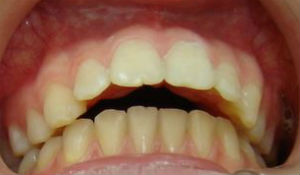
Distal bite (prognathic) is one of the most common dentofacial anomalies, which can be observed both in the presence of deciduous teeth and when they are changed permanently.
The presence of a malocclusion always entails a lot of problems associated not only with aesthetics, but also with impaired chewing function, breathing and speech.
A person with malocclusion does not look aesthetically pleasing, which has a negative effect on the psyche.
A prognathic bite is a type of bite when the upper jawbone protrudes forward with respect to the mandibular. With this type of pathology, the ratio of all teeth is violated.
Distal bite is characterized by the following symptoms:
- The lower jaw, in relation to the upper, is shifted back.
- The upper jaw bone is highly developed, or the lower jaw is underdeveloped.
- Between the upper and lower incisors there is a longitudinal gap.
- In its absence, the upper teeth can be shifted inward.
Depending on the location of the upper teeth, the following forms of prognathic bite are distinguished:
- In the first case, there is torsion, a fan-shaped arrangement of the front teeth of the upper row and a narrowing of the lateral dentitions.
- In the second case, the palatal inclination of the upper central incisors is noted. The lateral incisors are rotated along the axis and deviate towards the lips. The longitudinal gap between the incisors of the upper and lower dentition is absent.
Facial signs of a distal bite:

- The face of the person is excessively convex.
- Shortening of the lower third of the face is observed.
- Shortening of the upper lip.
- The location of the lower lip behind the upper incisors.
- Half-open mouth as a result of incomplete closing of lips.
- The severity of the chin fold.
- Inadequate or complete lack of contact between the upper and lower front teeth.
- Depending on the inclination of the teeth, the front lip may protrude or, in the absence or offset, be flattened.
In the presence of a distal bite, chewing, respiratory and speech functions are disturbed. The degree of violation depends on the severity of the bite and other anomalies of the dentition.
Diagnosis of anomalies
When conducting diagnostics and drawing up a treatment plan for prognathic bite, an analysis of the profile of the face is important. The dentist should have a clear idea of which profile the patient will have as a result of the treatment.
The severity of the bite depends on the degree of difference in the size of the upper and lower jaws. A distal bite in its pure form is quite rare. Often there is a deep bite in combination with prognathic.
In addition, the distal bite is combined with abnormalities such as an open bite, incorrect positioning of individual teeth, and narrowing of the jaws.
- For the purpose of differentiated diagnosis of a variety of prognathic bite, tele-radiography is carried out with subsequent analysis, diagnostic models of jaws are made and investigated.
- To assess the condition of the temporomandibular joint and chewing muscle group, tomography, rheography, and electromyography are performed.
Video: “Bite correction in adults”
Causes
In all newborn children, the lower jaw is normally located behind the upper jaw at a distance of up to 10 mm. As a result, a gap forms between them.
In the process of breastfeeding, teething and the development of chewing function, the lower jaw occupies the correct position and the prognathic bite becomes orthognathic.
- It follows from this that one of the reasons for the development of a malocclusion is an early weaning of a child from the breast, which is associated with the absence of sucking efforts that stimulate the growth of the lower jaw.
- Such bad habits in children as sucking a dummy, toys, fingers contribute to malocclusion.
- Lack of calcium and fluoride in the body, exclusion or lack of solid food in the child’s diet, premature loss of milk teeth and refusal of prosthetics are factors contributing to the development of a distal bite.
- Congenital malformations of the jaw, consequences of birth trauma, impaired posture, trauma to the jaw can lead to malocclusion.
Anomalies in the development of occlusion are divided into:
- Congenital malformations that are inherited.
- Acquired defects in the development of the dentofacial system - appearing in the process of intrauterine development or in childhood.
The following factors influence the development of a distal bite:
- Chronic diseases of ENT organs.
- The presence of bad habits in a child.
- Premature loss of primary teeth.
The effect of heredity
Based on the studies, it was found that the prognathic bite is dominant.
- Under the influence of external factors, bite formation tendencies may develop or disappear.
- Therefore, if there is a predisposition to the formation of a distal bite, it is necessary to suppress its development in a timely manner.
Chronic diseases
Often the formation of a prognathic bite occurs as a result of the chronic course of colds.
- During the illness, due to nasal congestion, the child is forced to breathe through his mouth, which contributes to the formation of a high palate.
- The upper jaw thus narrows and stretches forward.
Bad habits
The presence of bad habits in children can cause the formation of a distal bite.

- They lead to a displacement of the lower jaw, a change in the shape and position of the dentition.
- Gradually, these violations are fixed and often lead to a change in the shape of the face.
- Such habits that affect the bite include sucking fingers, cheeks, tongue, lips, or various objects.
- Factors contributing to the formation of a prognathic bite include improper swallowing, malfunctioning of chewing, breathing through the mouth, and violation of speech articulation.
Treatment
Treatment of a distal bite is best started even before the permanent teeth change.
- Correction of the bite is aimed at stimulating the development and growth of the lower jaw and inhibiting the growth of the upper jaw, which is carried out using special devices.
- Myogymnastics can be included in the complex of therapeutic measures.
- An important point is also the exclusion of the reasons that provoked the development of anomalies (normalization of nasal breathing, elimination of bad habits).
Ways to correct the bite:
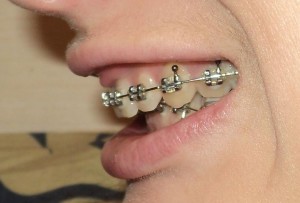
- Orthodontic therapy.
- Instrumental and surgical treatment.
- Surgical intervention.
- Combination therapy
Treatment of prognathic bite depends on the degree of development of the anomaly and on the age of the patient.
- With poor development of the lower jaw, you may need to push it forward.
- If the cause of the anomaly is a highly developed upper jaw, then it will need to be reduced.
Treatment of malocclusion in young children carried out using removable orthodontic structures (trainer, dental mouthguard).
The key objective of the apparatus is to restrain the growth and development of the upper jaw and stimulate the development of the lower jaw.
- Treatment of anomalies in adults (at a time when the growth of the jaw has ended) is carried out using such orthodontic designs as braces.
- In addition, a facial arch can be used and myogymnastics recommended. Myotherapy is necessary for active training of the circular muscle of the mouth, as well as strengthening the chewing muscle group.
- In order to reduce the size of the lower jaw, one or more teeth may be removed.
Forecast
- Fulfillment of all the doctor's recommendations during the period of occlusion correction in childhood and adolescence allows us to count on a positive result, both from the side of aesthetics and functionality.
- It should be understood that the correction of any malocclusion is a lengthy process, the duration of which is not 1-2 years, but several years.
- Moreover, active treatment can last on average from 3 to 4 years, and the retention period of the result is twice as long.
Therefore, it is much easier to prevent the formation of anomalies using preventive measures than to correct it in the future.
Complications
Not every owner of a prognathic bite realizes that such a condition is a pathology.
In the process of life, a person adapts to the characteristics of the bite and he is only concerned about the presence of aesthetic problems.
You should know that, sooner or later, the presence of a distal bite can cause the following consequences for the body:
- Impaired chewing function due to improper distribution of the load on the teeth during chewing.
- A high risk of developing caries of the posterior group of teeth, as they take on an increased load.
- Impaired swallowing function.
- The presence of a high risk of early development of periodontal disease.
- The appearance of regular pain during opening the mouth and chewing food in connection with problems of the temporomandibular joint.
- Difficulties with implantation and prosthetics.
Prevention of malocclusion
Measures to prevent the formation of a distal bite are as follows:
- The need for breastfeeding.
- Timely transfer of the child to the use of solid food.
- Prevention of chronic respiratory diseases.
- Prevention of violations of posture.
- Timely weaning of the child from bad habits.
- Prevention of rickets.
- Minimizing the use of dummies.
Photo: before and after
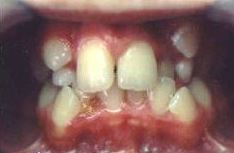 |
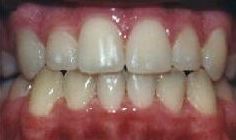 |
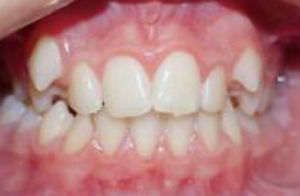 |
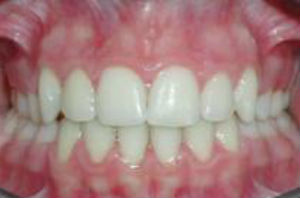 |
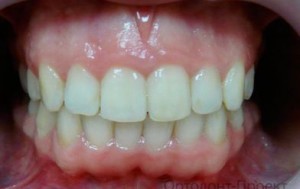 |
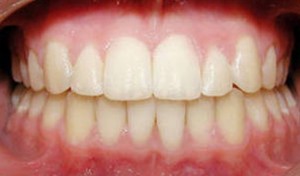 |